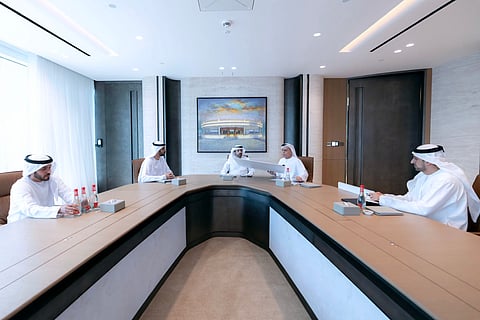Inside Dubai’s Future Loop project: From sidewalks to sky bridges
A landmark pedestrian network linking Dubai landmarks for year-round walkability

Dubai: Sheikh Hamdan bin Mohammed bin Rashid Al Maktoum, Crown Prince of Dubai, Deputy Prime Minister, Minister of Defence, and Chairman of The Executive Council, reviewed the progress of major infrastructure projects, including roads, public transport, aerial taxis, and The Future Loop project under the Dubai Walk Master Plan.
The review was held with Mattar Al Tayer, Director General of Dubai’s Roads and Transport Authority (RTA), and Omar Sultan Al Olama, Minister of State for Artificial Intelligence, Digital Economy and Remote Work Applications.
Also Read: Dubai conducts first manned air taxi flight
The Future Loop: transforming Dubai for pedestrians
The Future Loop project is a cornerstone of the Dubai Walk Master Plan, designed to make the emirate a pedestrian-friendly city year-round. The plan includes 3,300 km of new walkways, rehabilitation of 2,300 km of existing routes by 2040, and construction of over 110 pedestrian bridges and tunnels to improve connectivity.
A signature feature is an iconic 2 km bridge linking landmarks such as Dubai World Trade Centre, Museum of the Future, Emirates Towers, and DIFC, with widths ranging from 6 to 15 metres. The bridge includes a climate-controlled upper level of 30,000 m² for year-round use, complemented by an additional 30,000 m² of landscaped open spaces with shaded areas to reduce ambient temperatures and enhance comfort.
The initiative aims to raise pedestrian and individual mobility from 13% today to 25% by 2040, reflecting Dubai’s focus on sustainable, human-centred urban planning.
Key highlights:
The Future Loop project: cornerstone of the Dubai Walk Master Plan for year-round pedestrian access.
Walkways and connectivity:
3,300 km of new walkways.
Rehabilitation of 2,300 km of existing routes by 2040.
Over 110 pedestrian bridges and tunnels to enhance inter-area connectivity.
Iconic 2 km bridge:
Connects Dubai World Trade Centre, Museum of the Future, Emirates Towers, and DIFC.
Widths range from 6 to 15 metres.
Climate-controlled upper level of 30,000 m² for year-round use.
Additional 30,000 m² landscaped open spaces with shading for comfort.
Mobility goals: increase pedestrian and individual mobility from 13% today to 25% by 2040.
Urban planning focus: promotes sustainable, human-centred city design.
eVTOL flights and new infrastructure
Sheikh Hamdan was also briefed on other key projects. The Aerial Taxi project by Joby Aviation Inc. recently completed its first crewed eVTOL flight. The electric aerial taxis feature six propellers, four independent battery packs, a 160 km range, speeds up to 320 km/h, and accommodate four passengers plus the pilot. Vertiports are under construction, including a 3,100 m² facility near DXB with take-off/landing pads and passenger amenities.
Major rail network expansion
Rail expansion continues with the Blue Line project, which will increase Dubai Metro and Tram coverage from 101 km to 131 km by 2029, adding 14 stations and expanding the fleet from 140 to 168 trains.
RTA’s integrated infrastructure plan includes 72 projects spanning 226 km of roads, 115 bridges and tunnels, and 11 main corridors to enhance connectivity across the emirate by 2027.
Building a connected, sustainable city
Sheikh Hamdan highlighted that Dubai’s investments in infrastructure, including The Future Loop, reflect a long-term vision to create a connected, innovative, and sustainable city that enhances quality of life while setting global benchmarks for smart urban design.
Sign up for the Daily Briefing
Get the latest news and updates straight to your inbox





